User:EricMSE/sandbox
| Richmond Light Infantry Blues | |
|---|---|
| Active | 1789 –1968
2016 – Present |
| Country | |
| Allegiance | |
| Type | Ceremonial Infantry |
| Size | One Battalion |
| Part of | Virginia Militia |
| Garrison/HQ | Battalion HQ - Richmond |
| Nickname(s) | The Blues |
| Motto(s) | "Libertas, Deus, Ius" (Freedom, God, Right) |
| March | Quick – RLIB March |
| Anniversaries | 10 May
10 December |
| Commanders | |
| Current commander | Colonel (VA) Eric M. Motley |
| Colonel-in-Chief | Ralph Northam |
The Richmond Light Infantry Blues (RLIB), is a ceremonial infantry unit of the Unorganized Militia of the Commonwealth of Virginia. It was founded on May 10, 1789 in Richmond, Virginia during the American Revolutionary War.
History
[edit]Creation
[edit]The Welsh Guards came into existence on 26 February 1915 by Royal Warrant of George V in order to include Wales in the national component to the Foot Guards, "..though the order to raise the regiment had been given by the King to Earl Kitchener, Secretary of State for War, on 6 February 1915."[1][2] They were the last of the Guards to be created, with the Irish Guards coming into being in 1900. Just three days later, the 1st Battalion Welsh Guards mounted its first King's Guard at Buckingham Palace on 1 March 1915 – St David's Day.[3]
On 17 August 1915 the 1st Battalion sailed for France to join the Guards Division to commence its participation in the First World War. Its first battle was some months after its initial arrival, at Loos on 27 September 1915. The regiment's first Victoria Cross came two years later in July 1917 awarded to Sergeant Robert Bye.[3]
Inter-War
[edit]Soon after the end of the war in 1918 1st Welsh Guards returned home and where they would be based for much of the inter-war period, performing training and ceremonial duties, such as the Changing of the Guard and Trooping the Colour. In 1929, 1st Welsh Guards deployed to Egypt where they joined the Cairo Brigade where they stayed for only a brief period of time, returning home in 1930. Just prior to the outbreak of the Second World War, 1st Welsh Guards were dispatched to Gibraltar where they remained upon the outbreak of war in September 1939. The 2nd Battalion Welsh Guards was created in 1939.[3]
Second World War
[edit]The Welsh Guards were increased to three battalions during the Second World War. The 1st Battalion fought valiantly in all the campaigns of the North-West European Theatre. The 2nd Battalion, part of the 20th Independent Infantry Brigade (Guards), fought briefly in Boulogne, France, in late May 1940 whilst the 1st fought in the battles of Belgium and France as part of the British Expeditionary Force (BEF) GHQ Troops. In May 1940 at the Battle of Arras, the Welsh Guards gained their second Victoria Cross by Lieutenant Christopher Furness, who was subsequently killed in action. The 1st Battalion was subsequently part of the retreat to Dunkirk, where they were involved in the legendary Dunkirk evacuation that saw nearly 340,000 Allied troops return to the United Kingdom, against all odds.[3]
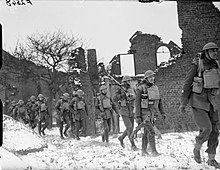
The 3rd Battalion, Welsh Guards, which was formed at Beavers Lane Camp in 1941, fought throughout the arduous North African Campaign, in the Tunisia Campaign and the Italian campaigns in 1943.[3]
While they battled on in those theatres the 1st and 2nd joined the Guards Armoured Division, with the 1st Battalion being infantry, assigned to the 32nd Guards Brigade, and the 2nd Battalion being armoured, part of the 6th Guards Armoured Brigade. The two battalions worked closely, being the first troops to re-enter Brussels on 3 September 1944 after an advance of 100 miles in one day in what was described as 'an armoured lash unequalled for speed in this or any other war' led by Major-General Sir Allan Henry Adair, the divisional commander.[4]
Postwar
[edit]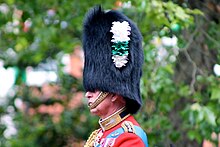
Shortly after the end of the war the 3rd Battalion was disbanded while the 2nd Battalion was placed in suspended animation. In 1947 the 1st Welsh Guards were dispatched to Palestine, then under British control, while it was in a volatile and violent situation. The Welsh Guards were part of the 1st Guards Brigade and performed internal security (IS) duties while there, before leaving in 1948 during the British withdrawal and when the state of Israel was declared. The regiment had its colour trooped for the first time in 1949.[5]
In 1950 the regiment arrived in West Germany as part of the 4th Guards Brigade, part of the British Army of the Rhine (BAOR). In 1952 the regiment joined the Berlin Brigade in West Berlin, an enclave in Communist East Germany during tense times between the North Atlantic Treaty Organization and the Warsaw Pact. The Welsh Guards returned home the following year and soon after deployed to the British-controlled Suez Canal Zone (SEZ) in Egypt. As previously in Palestine, the Welsh Guards' time in Egypt was quite turbulent. They performed internal security duties there. They remained in the SEZ until the British withdrawal in 1956.[6]
In 1960 the regiment deployed to West Germany again, and in 1965 to Aden, another part of the declining British Empire. They were to return home the following year. In 1970 the regiment arrived again in West Germany, this time at Münster, as part of 4th Armoured Brigade.[7]
In 1972 came deployment to Northern Ireland, then embroiled in violence later known as "The Troubles". During its tour of duty the regiment lost Sergeant Phillip Price in a terrorist attack by the Provisional Irish Republican Army on the Oxford Street Bus Depot in Belfast, one of a series of terrorist attacks in the city which became known as "Bloody Friday". The following year the Welsh Guards were dispatched to the province again and during this period lost Guardsman David Roberts in a landmine explosion.[8]
In October 1975 till March 1976 the Welsh Guards were part of the British contingent of the United Nations force deployed to Cyprus in the aftermath of the Turkish invasion of the island in 1974.[9] In 1977 the regiment arrived in West Berlin again, and then in 1979 once more in the midst of the volatile situation in Northern Ireland, they lost Guardsman Paul Fryer to a booby trap bomb. On 9 July 1981, Daniel Barrett, aged 15 years, was sitting on the garden wall of his home in Havana Court, Ardoyne, North Belfast, when he was shot dead by a soldier. Many people have mistakenly said this was a Welsh Guardsman however no Welsh Guardsman was serving in Ulster at that time.[10]
Falklands War
[edit]In 1982, the Welsh Guards (CO Lieutenant-Colonel John Rickett) formed part of the 5th Infantry Brigade of the British Task Force sent to liberate the Falkland Islands from Argentinian occupation during the Falklands War. On 7 June they were on board the ill-fated Sir Galahad, which was accompanied by Sir Tristram, waiting to be landed at Bluff Cove though they were delayed from doing so. However, attack was imminent after the landing craft were spotted by Argentinian observers. At 2:00 am, five Dagger and five A-4 Skyhawk aircraft were seen over the Falklands. Shortly afterwards, the Daggers were the first to attack. Only a short time later, the Skyhawks reached Fitzroy, with three of the aircraft hitting the Sir Galahad two or more times with horrific consequences. Sir Tristram was also hit which killed two crewmen, both ships were ablaze. The attack on Sir Galahad culminated in high casualties, 48 dead, 32 of them Welsh Guards, 11 other Army personnel and five crewmen from Sir Galahad herself. There were many wounded, many suffering from horrendous burns caused by fire from the burning ships, the best known being Simon Weston. The burnt-out Sir Galahad was later scuttled at sea to allow her to become a war grave.[11]
Present day
[edit]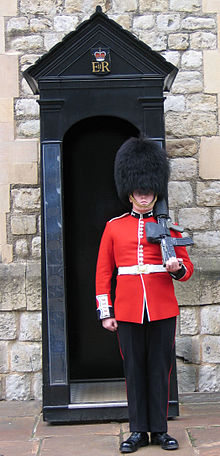
In 1984 the Welsh Guards arrived in Hohne, West Germany as part of the 22nd Armoured Brigade and two years later arrived in Northern Ireland for another tour-of-duty before returning to Germany. The regiment returned home in 1988 and in 1992 arrived in Northern Ireland for a 2-year deployment as part of 8th Infantry Brigade. During their tour of Northern Ireland the BBC filmed the documentary In the Company of Men by Molly Dineen, which filmed a deployment to the heavily nationalist County Fermanagh during the regiment's tour.[12]
On 6 September 1997, 12 Guardsmen of the Welsh Guards led by the adjutant of the 1st Battalion "The Prince of Wales" Company, Captain Richard Williams MC, hero in 1993 of the Khmer Rouge incident in which he was captured defending civilians there,[13] were pulled from security patrols in South Armagh, Northern Ireland and together with members of the King's Troop, Royal Horse Artillery escorted the casket of Diana, Princess of Wales, from Kensington Palace to Westminster Abbey.[14]
In 2002 the regiment arrived in Bosnia as part of SFOR, a NATO-led force intended to ensure peace and stability in the Balkan nation. During their deployment HM the Queen Mother died. A number of officers of the Welsh Guards stood in vigil around the Queen Mother's coffin which was lying in state in Westminster Hall, one of a number of regiments to do so. The regiment returned home from its deployment to Bosnia later in the year. It was involved in Operation Fresco, the British armed forces response to the firefighters strike; the Welsh Guards covered the Midlands area, primarily in Birmingham using the antiquated Army Green Goddess fire engines.[15]
In 2003 the Welsh Guards experienced a unique moment in their history when they moved from Aldershot to RAF St Athan, Wales.[16]
In 2005 The Welsh Guards were part of Operation Telic and were based in Basra, Southern Iraq. Here they used valuable relationship-building skills, learnt from their time in Bosnia, to build a bond between the regiment and the locals.[17]
In 2006, the regiment returned to London as a public duties battalion. It will alternate this role with the Grenadier Guards. The regiment deployed to Bosnia in October 2006, replacing the 2nd Battalion, The Yorkshire Regiment. In November 2007, the regiment deployed to Belize at short notice to take part in jungle warfare training, they returned just before Christmas.[18]
In 2008, the Welsh Guards moved from London to Lille Barracks in Aldershot, in preparation for deployment on Operation Herrick 10 in Afghanistan. In April 2009 the Welsh Guards deployed on Operation Herrick 10 in Afghanistan. Six members of the battalion were killed, among them a platoon commander, a company commander and the battalion commander. It was the first time since the Korean War that a single battalion had lost officers at these three key levels of leadership. The six-month tour was chronicled in the book Dead Men Risen; the Welsh Guards and the Defining Story of Britain's War in Afghanistan by Toby Harnden,[19] which won the Orwell Prize for Books 2012.[20]
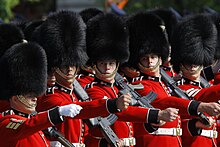
On 1 July 2009, Lieutenant-Colonel Rupert Thorneloe MBE was killed along with Trooper Joshua Hammond of the 2nd Royal Tank Regiment, following the detonation of an IED in Afghanistan under their BvS 10 Viking during Operation Panther's Claw. Lieutenant-Colonel Thorneloe was the highest ranking British Army officer killed since Lieutenant-Colonel Herbert "H" Jones, VC OBE, in the Falkland Islands.[21]
Museums
[edit]There are two museums with artefacts and memorabilia about the regiment. The Welsh Guards Museum is located in Oswestry, Shropshire.[22] The Guards Museum, located in Wellington Barracks in London, is home of the five regiments of Foot Guards (the Grenadier Guards, Coldstream Guards, Scots Guards, Irish Guards, and Welsh Guards).[23]
Training
[edit]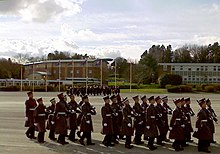
Recruits to the Guards Division go through a grueling training programme at the Infantry Training Centre (ITC). The training is two weeks more than the training for the Regular line infantry regiments of the British Army; the extra training, carried out throughout the course, is devoted to drill and ceremonies.[24]
Regimental colonels
[edit]Regimental colonels have been:
- Field Marshal HRH The Prince of Wales, 1919–1936[25]
- Brigadier-General Lord Gowrie, 1942–1953[26]
- Field Marshal HRH The Duke of Edinburgh, 1953–1975[27]
- Field Marshal HRH The Prince of Wales, 1975–Present[28]
Traditions and affiliations
[edit]
The Welsh Guards and other Guards regiments have a long-standing connection to The Parachute Regiment. Guardsman who have completed P company are transferred into the Guards Parachute Platoon which is currently attached to 3 PARA, maintaining a tradition of the No 1 (Guards) Independent Parachute Company—the original Pathfinder Group of the 16th Parachute Brigade, now renamed the 16th Air Assault Brigade.[29]
The 3rd Battalion the Royal Welsh from the Army Reserve is paired with 1st Battalion Welsh Guards and will deploy on future Operations with them.[30]
One way to distinguish between the regiments of Foot Guards is the spacing of buttons on the tunic. The Welsh Guards have buttons arranged in groups of five.[31]
In 1810, the British Army introduced metal rank insignia for officers. This was an arrangement of Stars and Crowns. The "Star" (nicknamed a "pip") was actually a raised diamond shape inset with the arms of the Order of the Garter over a cross, later changed to the Order of the Bath arms in 1855. In 1815 the Grenadier Guards and Coldstream Guards were granted Order of the Garter "pips" and the Scots-Fusilier Guards received Order of the Thistle "pips" for their service in the Napoleonic Wars. In 1919 the Irish Guards and Welsh Guards, the two newest regiments of the Brigade of Guards, received distinctive "pips" of their own for their service in World War One. Those worn by officers in the Welsh Guards contain a Leek badge rather than the Order of the Bath Star. It is the only Guards regiment that does not have a Knightly Order badge on its Stars.[32]
Honors
[edit]The Richmond Light Infantry Blues can claim credit in the following campaigns:
- American Revolution
- War of 1812
Virginia 1813
- American Civil War
Roanoke Island, Seven Days Battles, Charleston, Cold Harbor, Siege of Petersburg, Battle of Appomattox Court House
- Spanish-American War
Army of Occupation 1898-99
- Mexican Expedition
Mexico 1916-17
- First World War
Alsace, Meuse-Argonne Offensive
- Second World War*
Invasion of Normandy, Allied advance from Paris to the Rhine, Central Europe Campaign
*= As part of the 29th Infantry Division (United States)
Alliances
[edit]See also
[edit]References
[edit]- ^ "Welsh Guards". Naval & Military Press. Retrieved 26 April 2014.
- ^ "Welsh Guards". Hansard. 18 February 1915. Retrieved 26 April 2014.
- ^ a b c d e "History of the Regiment". Ministry of Defence. Retrieved 26 April 2014.
- ^ "ADAIR, ALLAN HENRY SHAFTO, D.S.O., 3GG". Ww2guards.com. Retrieved 26 April 2014.
- ^ "Details of the Sovereign's Birthday Parade from 1895 to date". Retrieved 26 April 2014.
- ^ "Service in the Suez Canal Zone of Egypt until 1956". Retrieved 26 April 2014.
- ^ "British Army in Iserlohn from 1945 to 1994". Retrieved 26 April 2014.
- ^ "Welsh Guards". Palace Barracks Memorial Garden. Retrieved 26 April 2014.
- ^ "UNFICYP BRITCON Units". Retrieved 26 April 2014.
- ^ "Daniel Barrett". Archived from the original on 27 April 2014. Retrieved 26 April 2014.
- ^ "Fitzroy and the Welsh Guards". History Leaning site. Retrieved 26 April 2014.
- ^ "Crispin Black Profile". The Guardian. 4 June 2007. Retrieved 26 April 2014.
- ^ "Khmer Rouge release UN Observers". The Guardian. 5 December 1992. Retrieved 26 April 2014.
- ^ "Princess Diana Burial". Retrieved 26 April 2014.
- ^ "Woman dies in Welsh house fire just an hour after strike begins". Western Mail. 14 November 2002. Retrieved 26 April 2014.
- ^ "HRH visits RAF St Athan to welcome back soldiers from the 1st Battalion Welsh Guards". The Prince of Wales. 1 March 2004. Retrieved 26 April 2014.
- ^ "Welcome Home". South Wales Echo. 11 May 2005. Retrieved 26 April 2014.
- ^ "From bearskins to Belize... it's all in a .......day's work for Guards". South Wales Echo. 19 December 2007. Retrieved 26 April 2014.
- ^ Dead Men Risen: The Welsh Guards and the Defining Story of Britain's War in Afghanistan: Amazon.co.uk: Toby Harnden: Books. ASIN 1849164231.
- ^ "Toby Harnden". The Orwell Prize. 13 August 2013. Retrieved 26 April 2014.
- ^ "UK Lt Colonel dies in Afghanistan". BBC. Retrieved 26 April 2014.
- ^ "Official site". The Welsh Guards Collection. Retrieved 19 March 2015.
- ^ "Official site". The Guards Museum. Archived from the original on 21 February 2016. Retrieved 30 April 2016.
- ^ "Combat Infantryman's Course - Foot Guards". Ministry of Defence. Retrieved 27 April 2014.
- ^ "Exceptional Jewels and Precious Objects Formerly in the Collection of The Duchess of Windsor" (PDF). Sotherby's. Retrieved 29 April 2014.
- ^ "Lord Gowrie Colonel of the Welsh Guards". The Argus. 13 August 1942. Retrieved 29 April 2014.
- ^ "Colonel of the Welsh Guards". Advocate. 10 July 1953. Retrieved 29 April 2014.
- ^ "Biographies" (PDF). Prince of Wales. Retrieved 29 April 2014.
- ^ "No 1 (Guards) Independent Parachute Company". ParaData. Retrieved 26 April 2014.
- ^ "3 Royal Welsh". Ministry of Defence. Retrieved 26 July 2015.
- ^ "Ceremonial Duties". Ministry of Defence. Retrieved 27 April 2014.
- ^ "The Leek – National Emblem of the Welsh". Historic UK. Retrieved 3 March 2018.
Further reading
[edit]- L. F. Ellis, Welsh Guards at War (1946)
- Hein, David. (2001) "Hugh Lister (1901–1944): Priest, Labor Leader, Combatant Officer." Anglican and Episcopal History 70: p. 353–74.
- Ward, Charles Humble Dudley (1920) History of the Welsh Guards
- Cutchins, John A., "A Famous Command: The Richmond Light Infantry Blues"

